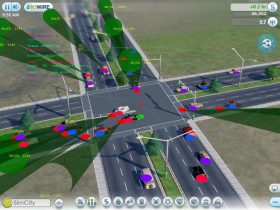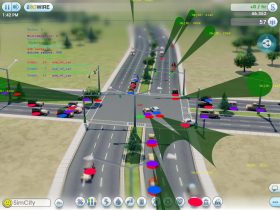Een nieuwe blog is op de officiële website van SimCity verschenen, de Nederlandse vertaling is er natuurlijk nog niet maar die zal spoedig, ergens in de komende dagen, wel verschijnen. En dan melden wij het uiteraard meteen! Dit keer is de blog geschreven door Kent Jolly die vooral over het geluid gaat, klik op ‘meer lezen’ voor de volledige tekst.
Hello, I’m Kent Jolly, the audio director for the new SimCity coming out in February 2013. I’ve been with Maxis since 1998. The first big game that I worked on was SimCity 3000 as a sound designer, and from there I went on to work on The Sims, SimCity 4, and Spore. It’s really cool to be working on SimCity again after such a long time. There is so much more we can do now than we could have done before. Today, I’m going to talk a little bit about how we’ve implemented traffic sound effects in this game, as well as give you a peek into some of the music.
One of my favorite aspects of SimCity, and especially this new SimCity, is the challenge of creating a great traffic and city ambience. The reason I’m singling out the traffic is because it’s amazing how different it is this time around. Because of the GlassBox engine, the traffic is no longer a representation of congestion or road type, it’s actually showing you where people in your city are going. People are on their way to work, going out of town, going to the shop, going home, etc. That means that cars don’t just disappear because there isn’t “traffic” there, and it means that you don’t see trucks in an industrial area just because it’s an industrial area, you see all of this happen in your city because it’s really moving resources from a manufacturing plant to a commercial store etc. So, how does that affect audio?
In previous SimCity games we simply counted the number of cars and then played sounds randomly in that general area to replicate the simulation. If it was residential area then you got “residential” car sounds, and if it was an “industrial” area you heard more truck sounds, etc. In this SimCity the cars are actually tracked individually! We wait for a car to hit a stop light and then when it leaves the intersection we can play a sound of a car pulling away and not just any car sound, the right car sound! We can also track the car as it moves and play a sound as it drives past.
We also change the sound based on the SimSpeed of the game. As the cars go faster and faster we adjust the audio to match what you see, but it remains true to the actual traffic. We’re showing you the visuals of the audio debug; it won’t look like this in the game, but we’ve left it up so you get a sense of where and how the sounds are actually playing.
So, that’s the traffic system in a nut shell.
The music in our game is something we’re also pretty excited about. We’ve decided to work with Chris Tilton, a composer in LA who works on the Fringe and Alcatraz TV series. He’s been doing great work for us, and we’re going to be recording with a full orchestra in late August.
The music in SimCity has always been very strong, but the one thing it didn’t have was have any interactivity. There was as set of great songs written and a jukebox that played those songs for you in random order. In this SimCity, we don’t want to lose that. There is still great music to be listened to, but we also want to subtly adjust the music to your experience. There’ a few ways we do that the most important being that we adjust the mix of the music based on various game states.
An example of this is when you are zoomed out, you’ll hear a fuller version of the score, but when you zoom in, we take away certain elements off the tracks. This also brings down the music in general. We did this is to help make room for all the activity going on in your city. We also add various elements to the music when you open up a data view. The music also shifts when you enter edit mode on a building, shifting to a much more rhythmic focused track. Each time you enter the editor the music will pick a set of tracks to put together on the fly. Lastly, the music tracks are written with population in mind, and we expose the full playlist as your city develops and grows in population.
So that’s it! These are just two ways in which the game has changed since nearly nine years ago. There’s a lot more in store! I thought I’d leave you with one of our early tracks, there are still a few things yet to do on it, but I think it’s cool enough to show off! Thanks for your time.

